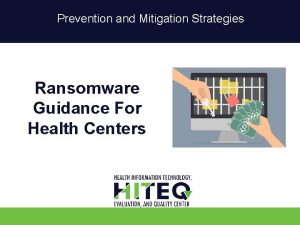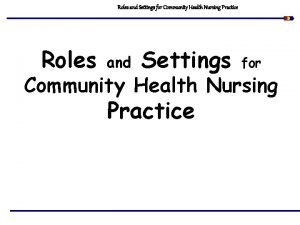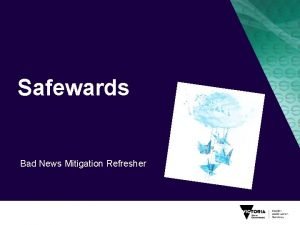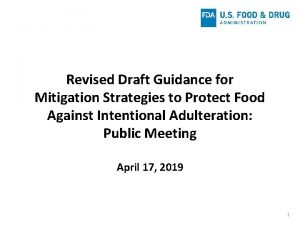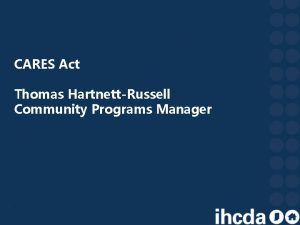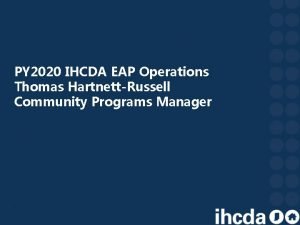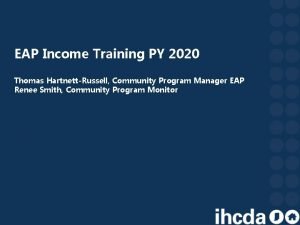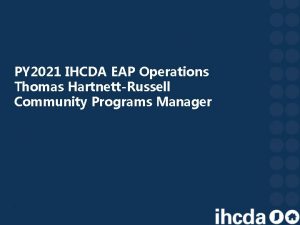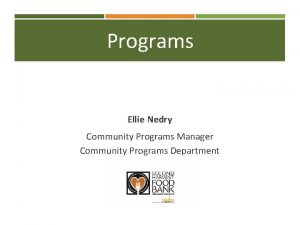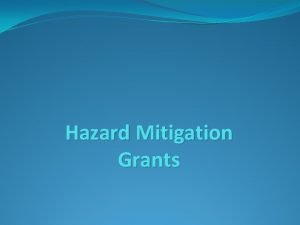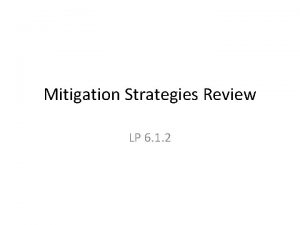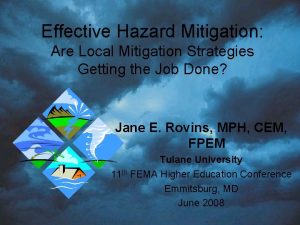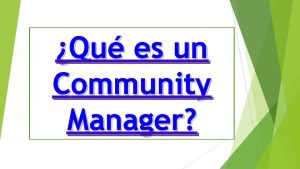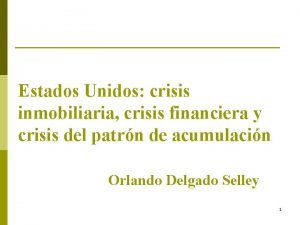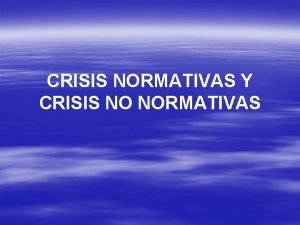Crisis Mitigation Strategies Thomas HartnettRussell Community Programs Manager

















- Slides: 17

Crisis Mitigation Strategies Thomas Hartnett-Russell Community Programs Manager 1

AGENDA 1. Crisis Mitigation Overview 2. Strategies for Compliance 3. Questions 2

CRISIS MITIGATION OVERVIEW 3

DEFINING CRISIS • The federal LIHEAP Statute (42 U. S. C. 8623, § 2605) requires a timely and effective energy crisis intervention program for households in need of immediate assistance. • The statute defines “timeliness” as providing some sort of assistance within 48 hours after a household applies for benefits, or within 18 hours after a household applies if a life-threatening situation exists. • The statute also requires that administering entities accept applications at sites that are geographically accessible to all households in the service area, and to either provide a means to those who are “physically infirm” to submit applications without leaving the home or provide transportation to application sites for such individuals. • IHCDA interprets the timeline of the statute to extend to the time of initial communication, even if an application has not yet been submitted. 4

DEFINING CRISIS • Crisis will be defined as any of the following situations: ‐ For non-bulk utilities, a household will be considered to be in crisis if it has a received a current disconnection notice on the utility but is not yet disconnected, or has already been disconnected. ‐ For prepaid non-bulk utilities, a household will be considered to be in crisis if it is within ten (10) days of running out of funds based on the average daily usage for the past thirty (30) days, or has already run out of funds. ‐ For bulk fuels, a household will be considered to be in crisis if the fuel tank is at or below 25% of capacity, or completely out of fuel. ‐ For biofuels, a household will be considered to be in crisis if it is within ten (10) days of running out of a supply of fuel, or if it is already out of fuel. 5

DEFINING LIFE-THREATENING CRISIS • When a life-threatening situation exists, the timeline to perform a mitigating action shortens to 18 hours. • A life-threatening crisis is defined as a situation in which the heating or electric utility is already shut off or bulk or biofuel is completely depleted, and the household also meets one of these criteria: 6 • The household qualifies as an at-risk household. • There is a documented medical need with an extreme safety concern. • There is a need for a propane tank safety inspection.

DEFINING MITIGATION • When a household meets crisis or life-threatening crisis criteria, action must be taken within the 48 - or 18 -hour timeline. • A mitigating action is an action taken by the LSP that will resolve the immediate energy crisis. • All actions taken must be documented by the LSP in case notes. • Mitigation can include determining eligibility and awarding a benefit within the 48 - or 18 -hour timeline, but there is an array of other actions an LSP can take that can meet the requirement. • The statute gives IHCDA broad latitude to define mitigation. 7

DEFINING MITIGATION • Mitigating actions for crisis and life-threatening crisis can include: 8 • Scheduling an intake appointment to take place within 48 or 18 hours, as required. • Calling the vendor to inform them that the applicant has applied and is covered under Indiana’s Moratorium legislation, if the application is turned in after December 1. • Calling the vendor to request an extension of the disconnection. • Providing the applicant with a list of other resources for assistance in the community.

DEFINING MITIGATION • LSPs must also have a method of providing information about mitigating a crisis during non-business hours. • 9 The easiest way to meet this requirement is to ensure that the LSP’s or EAP department’s outgoing voicemail message refers clients to other local organizations that provide assistance, such as the township trustees, or to 211 for further referrals.

DOCUMENTING MITIGATION • Because crisis mitigation is a requirement in the federal LIHEAP statute, it is vital that all LSPs and intake caseworkers are cognizant of the need to document all mitigation actions take, including the times. • Documentation can be in the form of case notes in the database or hard copy documents. • The documentation must be able to “tell the story” in a linear way and objectively show that we followed policy and met the requirements. • Remember, if an auditor walks in and looks at the file, this person will not have any pre-existing knowledge of the case, and intake caseworkers must keep in mind that this is the audience for their case notes. There should be no inferences left unexplained or assumptions that SOP was followed. • If it wasn’t documented, it didn’t happen! 10

MITIGATION COMPLIANCE STRATEGIES 11

PROVIDING CRISIS MITIGATION • When a potential applicant calls you stating that they are in crisis, if you are with an LSP that uses appointments, attempt to schedule an appointment within 48 or 18 hours. Take note of the date and time of the call, and include that in the case notes when you determine eligibility as well as the date and time of the appointment. This is a very easy and straightforward way of meeting the requirement. 12 • If your LSP does offer appointments, cushioning your appointment slots (e. g. , if an appointment typically runs an hour, scheduling them for an hour and a half) or under-booking your slots (e. g. , scheduling three appointments when four intake caseworkers are available) can help you maintain availability to handle crisis in a timely manner. • Some LSPs also designate one or two days as “crisis days” and do not schedule any advance appointments on those days.

PROVIDING CRISIS MITIGATION • Maintain a community resource list or packet, consisting of other agencies in the community that provide resources for assistance. Keep hard copies of this list available and provide them to clients who are in crisis, or even to all clients who apply. • If you have a generic e-mail inbox for EAP correspondence, set it up to autorespond to everyone who e-mails it. The auto-response e-mail can include referrals to other resources or instructions to call 211 for additional assistance. 13

PROVIDING CRISIS MITIGATION • Vendor CSRs can sometimes not be aware of moratorium requirements, or can be resistant to offering the protection before eligibility is determined. If you do talk to someone at one of your vendors who understands the requirements and works with you on it, try to maintain a relationship with that person and talk to them whenever you need to suspend disconnection while determining eligibility. • Draft a form letter that you can send to your vendors when somebody submits an application and needs moratorium protection while you determine eligibility. Be sure to leave a space to enter the applicant’s name and utility account number. Don’t be afraid to quote the applicable parts of the legislation or the numerical Indiana Code identification. 14

DOCUMENTING CRISIS MITIGATION • Be sure to date stamp every piece of paper that comes through your door! Date stamping is at least half the job of telling the story of the file, and can explain processing delays when they happen (e. g. , an applicant turned in an application on November 5 but did not turn in a required piece of documentation until November 14. ) • If you are able to time-stamp documents also, this can help document that we met the requirements for mitigating life-threatening crisis. • Take plentiful meaningful case notes! Try to make it a habit to always leave a note in the database whenever you must go into a file. Make your notes specific, not vague. Make a note of every interaction you have with an applicant, including copies of correspondence (e. g. , incomplete letters). 15

DOCUMENTING CRISIS MITIGATION • When opening mail, take a look over the mail-in applications rather than just filing them blindly. Separate out any that appear to be in crisis and make those priorities. • Make good use of the Application Actions in RIAA! If you give a referral or even if you just have a resource list or packet that you give to applicants, it is quick and easy to set up an Application Action to streamline your documentation of this. • When a crisis client calls you, try to take notes during the call and then add them to the case file. • It bears repeating: If you don’t document it, it didn’t happen! 16

QUESTIONS? 17
 Ransomware mitigation strategies
Ransomware mitigation strategies Myasthenic crisis vs cholinergic crisis
Myasthenic crisis vs cholinergic crisis Cpmcd full form
Cpmcd full form List of emerging manager programs
List of emerging manager programs Developing price strategies and programs
Developing price strategies and programs Segmented pricing
Segmented pricing Developing pricing strategies and programs
Developing pricing strategies and programs Developing pricing strategies and programs
Developing pricing strategies and programs Community health education outreach programs
Community health education outreach programs Senior manager vs general manager
Senior manager vs general manager Portfolio manager synergy manager parental developer
Portfolio manager synergy manager parental developer Pathologist and anthropologist
Pathologist and anthropologist Web community manager
Web community manager Community health nurse manager role
Community health nurse manager role Portafolio community manager plantilla
Portafolio community manager plantilla Somerset mold removal
Somerset mold removal Bad news mitigation
Bad news mitigation Mitigation strategy examples
Mitigation strategy examples
